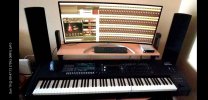I use IK Multimedia’s ARC 3 software, running as a VST/AU in SoundSource for all of my music listening over speakers and equalization for my headphones. ARC 3 is an automated version of EQing using REW that measures 21 points from both speakers in predetermined patterns for various setups. In addition to EQ it will adjust balance and phase to optimize the stereo image. You can have as many setups as you want. I have one for my near field position and one for farther away position. You can also PEQ the resulting EQ to taste. And it will simulate various other forms of speakers (laptop, sound bars, headphones, etc. which is nice for mastering).
While I have treated my room a bit, it is non-ideal in size and symmetry so I consider ARC3 non-optional to the extent that I run my turntable through my computer. And since I’m doing that, I use de-clicking VSTs as well. If I could find a good one, I would likely use a noise filter as well, but all the ones I have tried still alter the music.
I don’t consider myself an audiophile, just someone who really enjoys listening to and making music.



